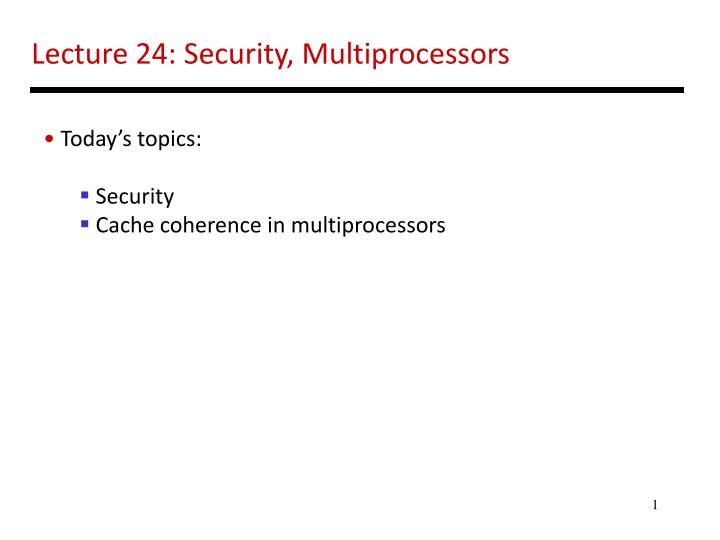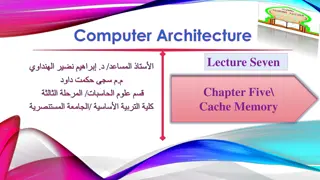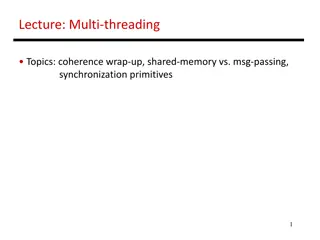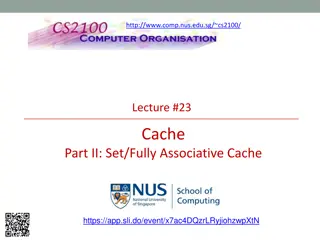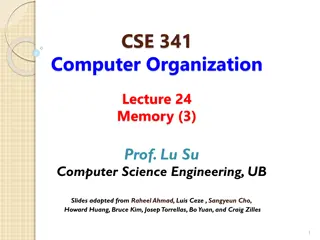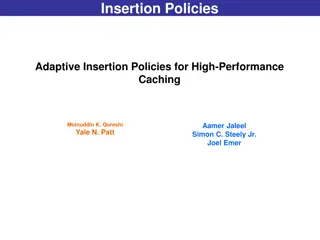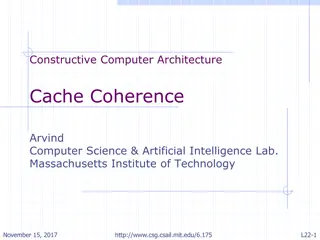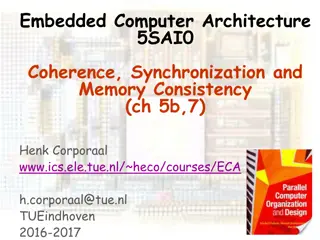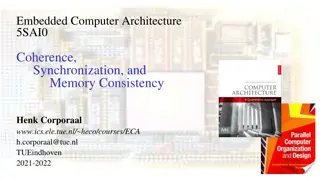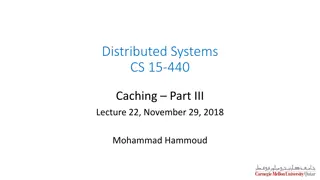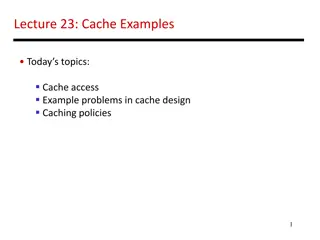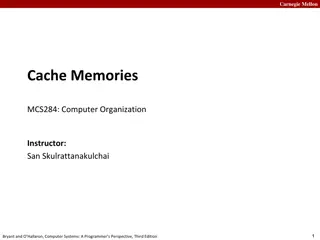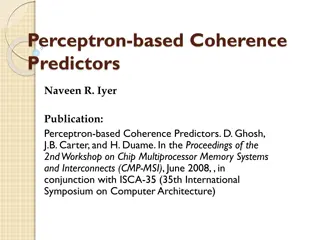Security and Cache Coherence in Multiprocessors
Today's lecture covers key topics such as security vulnerabilities like Meltdown and Spectre variants in multiprocessors. Explore issues related to cache coherence, processor architectures, and memory organization in multiprocessor systems.
Download Presentation

Please find below an Image/Link to download the presentation.
The content on the website is provided AS IS for your information and personal use only. It may not be sold, licensed, or shared on other websites without obtaining consent from the author.If you encounter any issues during the download, it is possible that the publisher has removed the file from their server.
You are allowed to download the files provided on this website for personal or commercial use, subject to the condition that they are used lawfully. All files are the property of their respective owners.
The content on the website is provided AS IS for your information and personal use only. It may not be sold, licensed, or shared on other websites without obtaining consent from the author.
E N D
Presentation Transcript
Lecture 24: Security, Multiprocessors Today s topics: Security Cache coherence in multiprocessors 1
Meltdown 2
Spectre: Variant 1 if (x < array1_size) y = array2[ array1[x] ]; 3
Spectre: Variant 1 x is controlled by attacker Thanks to bpred, x can be anything array1[ ] is the secret if (x < array1_size) y = array2[ array1[x] ]; Victim Code Access pattern of array2[ ] betrays the secret 4
Spectre: Variant 2 Victim code R1 (from attacker) R2 some secret Label0: if ( ) Attacker code Label0: if (1) Label1: Victim code Label1: lw [R2] 5
Multiprocessor Taxonomy SISD: single instruction and single data stream: uniprocessor MISD: no commercial multiprocessor: imagine data going through a pipeline of execution engines SIMD: vector architectures: lower flexibility MIMD: most multiprocessors today: easy to construct with off-the-shelf computers, most flexibility 6
Memory Organization - I Centralized shared-memory multiprocessor or Symmetric shared-memory multiprocessor (SMP) Multiple processors connected to a single centralized memory since all processors see the same memory organization uniform memory access (UMA) Shared-memory because all processors can access the entire memory address space Can centralized memory emerge as a bandwidth bottleneck? not if you have large caches and employ fewer than a dozen processors 7
Snooping-Based Protocols Three states for a block: invalid, shared, modified A write is placed on the bus and sharers invalidate themselves The protocols are referred to as MSI, MESI, etc. Processor Processor Processor Processor Caches Caches Caches Caches Main Memory I/O System 8
Snooping-Based Protocols Three states for a block: invalid, shared, modified A write is placed on the bus and sharers invalidate themselves The protocols are referred to as MSI, MESI, etc. Processor Processor Processor Processor Caches Caches Caches Caches Main Memory I/O System 9
Example P1 reads X: not found in cache-1, request sent on bus, memory responds, X is placed in cache-1 in shared state P2 reads X: not found in cache-2, request sent on bus, everyone snoops this request, cache-1does nothing because this is just a read request, memory responds, X is placed in cache-2 in shared state P1 writes X: cache-1 has data in shared state (shared only provides read perms), request sent on bus, cache-2 snoops and then invalidates its copy of X, cache-1 moves its state to modified P2 reads X: cache-2 has data in invalid state, request sent on bus, cache-1 snoops and realizes it has the only valid copy, so it downgrades itself to shared state and responds with data, X is placed in cache-2 in shared state, memory is also updated P1 P2 Cache-1 Cache-2 Main Memory 10
Example Request Cache Hit/Miss Request on the bus Who responds State in Cache 1 State in Cache 2 State in Cache 3 State in Cache 4 Inv Inv Inv Inv P1: Rd X Rd Miss Rd X Memory S Inv Inv Inv P2: Rd X Rd Miss Rd X Memory S S Inv Inv P2: Wr X Perms Miss Upgrade X No response. Other caches invalidate. Inv M Inv Inv P3: Wr X Wr Miss Wr X P2 responds Inv Inv M Inv P3: Rd X Rd Hit - - Inv Inv M Inv P4: Rd X Rd Miss Rd X P3 responds. Mem wrtbk Inv Inv S S 11
Cache Coherence Protocols Directory-based: A single location (directory) keeps track of the sharing status of a block of memory Snooping: Every cache block is accompanied by the sharing status of that block all cache controllers monitor the shared bus so they can update the sharing status of the block, if necessary Write-invalidate: a processor gains exclusive access of a block before writing by invalidating all other copies Write-update: when a processor writes, it updates other shared copies of that block 12
Constructing Locks Applications have phases (consisting of many instructions) that must be executed atomically, without other parallel processes modifying the data A lock surrounding the data/code ensures that only one program can be in a critical section at a time The hardware must provide some basic primitives that allow us to construct locks with different properties Bank balance $1000 Parallel (unlocked) banking transactions Rd $1000 Add $100 Wr $1100 Rd $1000 Add $200 Wr $1200 13
Synchronization The simplest hardware primitive that greatly facilitates synchronization implementations (locks, barriers, etc.) is an atomic read-modify-write Atomic exchange: swap contents of register and memory Special case of atomic exchange: test & set: transfer memory location into register and write 1 into memory (if memory has 0, lock is free) When multiple parallel threads execute this code, only one will be able to enter CS lock: t&s register, location bnz register, lock CS st location, #0 14
Coherence Vs. Consistency Coherence guarantees (i) write propagation (a write will eventually be seen by other processors), and (ii) write serialization (all processors see writes to the same location in the same order) The consistency model defines the ordering of writes and reads to different memory locations the hardware guarantees a certain consistency model and the programmer attempts to write correct programs with those assumptions 15
Consistency Example Consider a multiprocessor with bus-based snooping cache coherence Initially A = B = 0 P1 P2 A 1 B 1 if (B == 0) if (A == 0) Crit.Section Crit.Section 16
Consistency Example Consider a multiprocessor with bus-based snooping cache coherence Initially A = B = 0 P1 P2 A 1 B 1 if (B == 0) if (A == 0) Crit.Section Crit.Section The programmer expected the above code to implement a lock because of ooo, both processors can enter the critical section The consistency model lets the programmer know what assumptions they can make about the hardware s reordering capabilities 17
